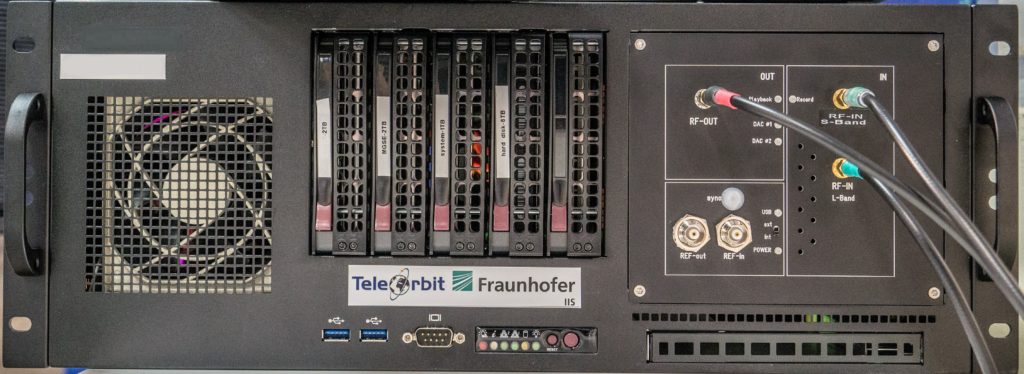-
Multi-GNSS Simulation & Test Environment

Functional Description
The objective of this development is to create a GNSS simulation environment that provides the possibility and flexibility to use both: synthetically generated data and recorded real-world samples – both exactly reproducible.
Such a tool considerably improves the development, qualification, and certification process of GNSS receivers within development phases and for the validation/certification in end-to-end tests. The MGSE© system consists of three basic elements.
XPLORA: Simulated and synthetically generated data
The multi-frequency, multi-system software-based GNSS simulation environment XPLORA consists of two modules – the satellite constellation simulator (SCS) and the intermediate frequency simulator (IFS).
The SCS simulates the satellite orbits by using a sophisticated orbit integrator including modelling of environmental parameters like satellite clocks, transmit power, antenna patterns, ionosphere, troposphere, and others. The IFS generates digital intermediate frequency signals including the simulation of a user definable radio frequency front-end (RFFE).
XPLORA comprises the GNSS Interference Analysis Tool (GIAT). Thus, it is possible to simulate jammers on top of the GNSS signals. The jamming signals can be defined by the user and include continuous wave jammer, swept continuous wave jammer as well as frequency modulated jammer.
The XPLORA simulation environment includes GPS, Galileo, GLONASS, and BeiDou constellations and generated IF signals.
MGSE© Recording Unit: Received and recorded real-world GNSS data
Beside the multi-band GNSS antenna, the main objective of the multi-band RF front-end (MGSE©-REC) is to receive the RF signal, to filter and amplify the incoming signal in different frequency bands simultaneously and then to down-convert and quantize the signals, in order to obtain digital intermediate-frequency forms, which can be used by the actual receiver.
The MGSE© Recording subsystem includes a new reception board to receive and process the NavIC / IRNSS S-band in addition the already available other frequency L-band combinations.
MGSE© Replay Unit: Replayed digital GNSS IF or analogue RF data
Both, synthetically generated and/or recorded real-world GNSS data can be replayed either as digital IF GNSS signals or as analogue RF multi-band data in real-time to receivers / components under test.
The MGSE© Replay Unit (MGSE©-REP) includes a flexible multi-band, USB3.0 digital and analogue RF replay device, that can stream the GIPSIE-IFS generated and MGSE©-REC recorded raw IF data to a digital baseband output or to an analogue RF signal. MGSE©-REP supports simultaneously up to four GNSS signals e.g. L1, E1, B1, G1. The product offers also up to three different analogue RF bands.
MGSE© integrated system
The MGSE© integrated system will be composed of
• XPLORA constellation and signal simulator software including analysis toolset and software defined receiver hosted on dedicated industrial grade computer
• MGSE© Recording Unit and
• MGSE© Replay Unit both connected to a.m. computer.
However, each element will also be functional as stand-alone unit.
Summary of key features
An appealing simulation environment for GNSS signal generation and simulation including record and replay functionality must comprise the following main flexible and modular components in software and also in hardware:
• Multi-system GNSS satellite constellation simulator
• Multi-system GNSS intermediate frequency signal simulator
• Multi-band GNSS antenna
• Multi-band RF front-end recorder
• Replay device for real-world recorded and synthetically simulated signals as digital IF and analogue RF version
MGSE© will be capable of providing both digital IF GNSS signals as well as analogue RF multi-band data in real-time to receivers / components under test. It will be possible either to synthetically generate data using the simulation modules, which are able to simulate arbitrary scenarios with different settings or effects, or to record real-world data. The GNSS data – both synthetically generated and recorded – can then be replayed (exactly reproducible).
Summary of key parameters
The key design characteristics of MGSE© are listed below:
| Performance parameter multi-system, multi-frequency scenarios |
SIM | REC | REP |
|
X X X X X X |
X X X “ X X X X |
X X X “ X X X X |
| Simulation of jamming & multipath signals | X | n/a | X |
| Notes: SIM = Simulation Channels & Signals REC = Receiving Channels & Signals REP = Transmitting Channels & Signals |
Acknowledgement: The MGSE© project has been supported and co-financed by ESA under Contract No.4000116130


